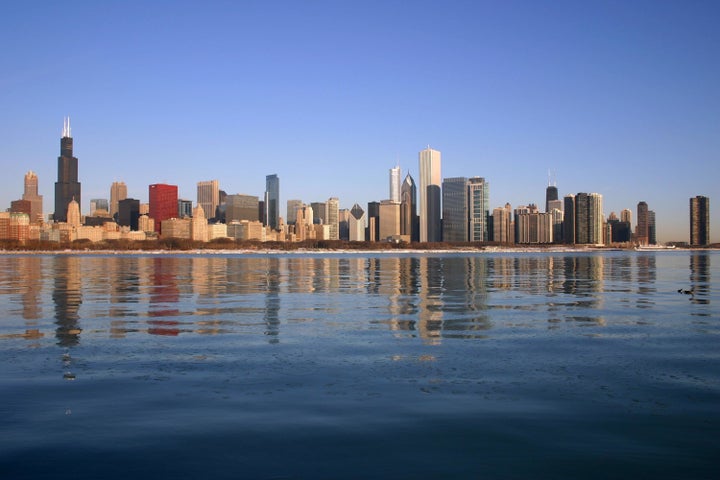
![]() Low water levels are visible almost everywhere you look in the normally water-rich upper Midwest right now. The Mississippi River is so low that it needs emergency blasting to clear rocks impeding barge travel. And the Great Lakes are approaching an all-time low, which could write a new chapter in the ever-fascinating history of the Chicago River.
Low water levels are visible almost everywhere you look in the normally water-rich upper Midwest right now. The Mississippi River is so low that it needs emergency blasting to clear rocks impeding barge travel. And the Great Lakes are approaching an all-time low, which could write a new chapter in the ever-fascinating history of the Chicago River.
As you probably know, Chicago’s city fathers pulled out one of the most celebrated engineering feats in modern history by reversing the river away from the Great Lakes to stave off all manner of waterborne illnesses that were infecting our drinking water; this is the so-called “Chicago Diversion.” The reversal effort could be undone in the coming months as drought conditions may lower Lake Michigan well below the height of the river, causing the waterway to flow back into the Lake as it originally did, rather than into the Mississippi River watershed as it was engineered to do a century ago.
As the Great Lakes are expected to reach historic lows this winter, gravity becomes a problem. Water flows down hill and the Army Corps of Engineers worry that an additional drop of six inches will be enough to undo the hydrology of the Chicago Diversion. That half-foot would make the lake lower than the river, which would flip the flow with the waterway reverting back to its natural course back into the Great Lakes.
Unfortunately, we have not really fixed the problems that necessitated the reversal to begin with: sewage and filth dumped into the river (plus the more recent issue of the waterways acting as invasive species superhighways). The river remains rife with human bacteria from undisinfected human waste released by water treatment plants. The regional water authority has finally agreed to install the equipment to disinfect sewage that comes into their plants, but the disinfection will happen far too late should the river spontaneously head into the lake this winter. And this equipment will not address the problem of uncontrolled sewer over flows that happen whenever there is more than an inch and a half of rain in the region -- thus, uncontrolled sewage flow will continue under present realities.
The Army Corps of Engineers is so worried that they announced last week that drastic measures are going to be necessary if Lake Michigan drops six more inches -- something that is within the realm of possibility if the drought that grips the region continues.
So, what is to be done to protect our water... again?
The Corps is going to bar the gates. Well, lock the locks that is, keeping the navigational barriers separating the river and lake closed in an effort to limit the pollution from seeping out into Lake Michigan for however long it takes for things to return to the unnatural, engineered normal that this city has come to rely on.
As amazing as it sounds, the situation is not entirely unique. The opposite problem of too much water sometimes forces the river to re-reverse itself. Occasional storms overcome the Chicago area sewage system, requiring release of untreated sewage into the lake. The resulting beach closures and swimming advisories underscores why Chicagoans (and the Great Lakes community generally) wants the mess to flow away from the lakes.
This situation is all part of a system proving itself to be unreliable, based on a model of a “status quo” that does not exist. Actual and threatened re-reversals make clear that the lake and river dynamics that the Chicago waterway system was built to address no longer exist. The system is broken, and cannot protect either the city or the lakes as it was designed to do. And, if you look at MWRD’s records, the lake and river hydrological conditions are getting all the more dynamic and variable (just look at the rapid increase in those river reversals). We have long known that conditions were far more dynamic than our system assumes, and were going to change even more rapidly with the impact of a changing climate. In the last several decades, the lakes have risen and fallen dynamically, with record high levels in the late 1980s, and “100 year storms” and flooding occurring every five years. Look at last year, and the floods that inundated the now drought challenged Mississippi Basin.
And what have we done in the face of actual experience and scientific models of actual situations? Very little. Except cling to a fictional status quo.
Which brings us to today. Hopefully, we will not be confronting the return of fatal waterborne illnesses threatening the Windy City. But, clearly, the idea that this “century of progress” is being undercut by the brutal swings associated with climate change creates a clarion call for action:
Action to fight climate change.
And active rethinking, re-visioning and repair of the highly engineered waterways that Chicago and the Great Lakes community has come to rely on.
Don’t forget that while we fret over the economic impact of impaired barge traffic along the Mississippi River today, last summer we were fretting over Big Muddy spilling its banks (with the federal authorities blowing up levees to keep towns in Southern Illinois from being washed away).
It is not just the rise and fall of water bodies that is threatening our safety and security, but the rapid switch between highs and lows that signals a new reality which is overcoming our infrastructure and putting us in harm’s way. The next 50 years of climate change are already baked into the cake, so we need to get serious about dealing with the changes already upon us. We must think big, while also deploying the tools we have on hand now, like green infrastructure, that can help us meet the immediate challenges and make our communities more resilient.
This past summer’s drought got people thinking about climate. Hurricane Sandy too. And now the Chicago River might change its mind and head out to the lake, jeopardizing drinking water for millions of people. The threat of changing climate is impossible to ignore. I hope we heed the call to thoughtful action before we get even deeper in trouble by relying on failed infrastructure, and a false sense of reality that simply doesn’t exist.
And I really hope the lake doesn't drop those last six inches...
This post originally appeared on NRDC's Switchboard blog.
